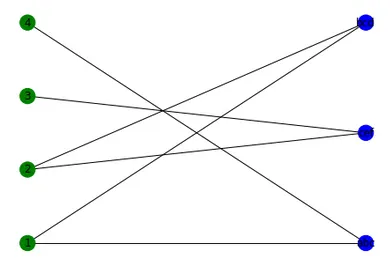如何在Python的networkX包中显示一个二分图,其中一类节点在左侧列中,另一类在右侧?
我可以创建一个图像并像这样显示它。
我可以创建一个图像并像这样显示它。
B = nx.Graph()
B.add_nodes_from([1,2,3,4], bipartite=0) # Add the node attribute "bipartite"
B.add_nodes_from(['a','b','c'], bipartite=1)
B.add_edges_from([(1,'a'), (1,'b'), (2,'b'), (2,'c'), (3,'c'), (4,'a')])
nx.draw(B)
plt.show()
但我希望将节点1、2、3、4放在左侧一列,将节点'a'、'b'、'c'放在右侧一列,并在它们之间建立连线。


nx.draw(B, pos=pos)中添加with_labels=True即可。 - Tobias P. G.